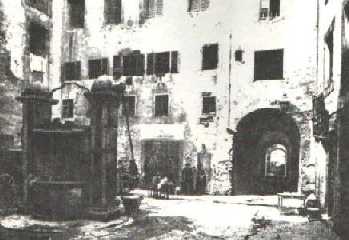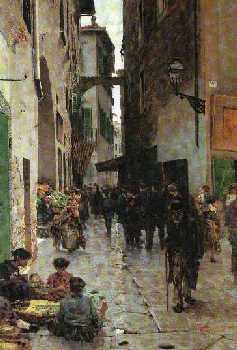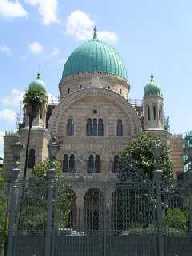Jewish Genealogy in Italy
Firenze (Florence)
There are traces of the presence of Jews in Firenze since the
Middle Ages, but a stable settlement in town is attested just since the 15th century.
From its beginning the Jewish Community lived in a relative freedom. The Medici family encouraged Jews to come in order to found the trade and Jews
were permitted to establish in town and to practise lend of money, activity forbidden to
Christians.
During the Republic, Jews lived in danger of expulsions, always revocated in
exchange of money.
In 1537 Cosimo de' Medici gained power in the Florentine government. The family Abravanel
who frequented the court influenced positively the behaviour of the Medici towards
Jews and the Medici gave refuge to Spanish and Portugese Jews. This was the start of
the growth of the Sephardic Jewish community in Florence.
Following the politicies of Counter- Reformation of the Pope, Cosimo
de' Medici begun to change his policies toward the Jews: in 1567 he forced Jews to wear
badges and in 1571 established a ghetto in Firenze.
For the Jews began a period of prohibitions and privation that lasted nearly three hundred
years. The ghetto had two exits closed by gates and was constituted by narrow streets
between high buildings with few sources of air and light.Following the politicies of
Counter- Reformation of the Pope, Cosimo de' Medici begun to change his policies toward
the Jews: in 1567 he forced Jews to wear badges and in 1571 established a ghetto in
Firenze.
Two synagogues were built in the Ghetto, in 1571 the Italian one and at the end of the
16th century the Spanish one.For the Jews began a period of prohibitions and privation
that lasted nearly three hundred years. The ghetto had two exits closed by gates and was
constituted by narrow streets between high buildings with few sources of air and
light.Following the politicies of Counter- Reformation of the Pope, Cosimo de'
Medici begun to change his policies toward the Jews: in 1567 he forced Jews to wear badges
and in 1571 established a ghetto in Firenze.
There were also schools, a butcher, a bakery, a ritual bathhouse. The Jews were allowed to
elect their own council and their rabbinical court had jurisdiction on legal
problems. |
|
 Florence, the Ghetto
Florence, the Ghetto |
Since the half of the 18th century many prohibitions begun to fall and when the French
troops came in Tuscany brought the values of the French Revolution and gave
civic rights and emancipation to the Jews. In 1848, the ghetto was abolished.
When Florence was the capital of Italy (from 1864 to 1872) begun a planning of deep
transformations of the town which brought to the demolition of part of the
historical center. The Ghetto was demolished and became the actual square
"Piazza della Repubblica".
The actual synagogue was inaugurated in 1882.
When the Nazis occupied Firenze in the autumn of 1943 about 2.500 Jews lived in town. In
November 1943 were deported 243 Jews. Only 13 returned.
| Number of the Jews in Firenze: |
| Year |
|
Jews in Firenze |
| 1571 |
|
500 |
| 1680 |
|
600 |
| 1800 |
|
1.100 |
| 1841 |
|
1.500 |
| 1871 |
|
2.500 |
| 1900 |
|
3.000 |
| 1938 |
|
2.500 |
| 1965 |
|
1.200 |
|
 |
|
Telemaco Signorini, Il ghetto di Firenze,
1882(?) |
Record Repositories:
- Jewish Community of Firenze
Address: Via Luigi Carlo Farini, 4, 50121 - Firenze;
- State Archive of Firenze
Address: Archivio di Stato di Firenze Viale Giovine Italia, 6 - 50122 Firenze
Tel: 055.26.32.01
E-mail: asfi@archiviodistato.firenze.it
State Archive of Firenze Webpage
- Firenze Town Archive
Address: Archivio Storico del Comune di Firenze - Via dell'Oriuolo, 33 - 50122 - Firenze
Tel. +39/0552616527
Firenze Town Archive Webpage
Resources
from the 17th to the 19th century:
List of records that can be found for the Jews of Firenze:
| Births |
Matrimonies |
Dearths |
Other |
|
|
|
Ketubot 1714-1815 |
| 1808-1817 |
1808-1817 |
1808-1817 |
Census of 1811 |
| 1818-1837 |
1818-1865 |
1839-1865 |
Census of 1841 |
| 1839-1865 |
1865-2000 |
|
Census of 1869 |
| 1865-2000 |
1882-2000 |
1865-2000 |
Census of 1871 |
- Jewish Cemeteries. Nothing has remained of the first Jewish
cemeteries of the Renaissance times. The oldest cemetery left is that one of Viale
Ariosto that was in use for a hundred years (1777 - 1870). After that cemetery begun to
be used the cemetery of Rifredi, a suburb of the town which is the actual
cemetery . Please contact for
further information.
Bibliography:
- Annie Sacerdoti, Guida al'Italia Ebraica, Marietti, Genova: 1986, English
transl. by Richard F. De Lossa, Guide to Jewish Italy, Israelowitz
Publishing, Brooklyn NY: 1989.
- Dora Liscia Bemporad and Anna Marcela Tedeschi Falco, Tuscany Jewish Itineraries:
Place, History and Art. Marsilio 1997.
- Umberto Fortis, Jews and synagogues: Venice, Florence, Rome, Leghorn; a practical
guide, Edizioni Storti, Venezia 1973.
- Roberto G. Salvadori, Breve storia degli ebrei toscani, Le Lettere, Firenze 1995.
Surnames of the Jews of Firenze :
Most frequent surnames found in documents of the 18th-19th centuries:
Acciaioli, Ambron, Bassano,
Bavà, Blanes, Bolaffi, Bollaffi, Borghi,
Cabib, Caivano, Calò, Camajoli, Campagnano, Cantone, Capua,
Carcasone, Carcassone, Cardoso Frias, Caro, Cassuto, Castelli, Castelnovo, Castelnuovo,
Castiglione, Cetona, Chimichi, Chimici, Cividalli, Coen, Collavecchia, Consiglio,
Corinaldi,
Defert, Del Maria, Della Vita, Della Pergola, Donati,
D'Urbino, Fano, Fano Del Sole, Felice, Ferro, Finzi, Forte,
Francini, Frias, Funaro,
Galletti, Gallichi, Gallico, Ghirone, Ginattau, Gori,
Graziadio, Laid, Laid Tedesco, Lep, Leps, Levi, Levi Valle,
Livi,
Mondolfi, Montefiore, Montefiori, Morelli, Moscato, Mussatti,
Nactè, Nepi, Orefice, Orvieto,
Ottolenghi,
Pacifici, Passigli, Pegna, Perez, Pereze, Pesero, Piazza,
Porzia, Prato, Procaccia, Pugliesi, Quillirici, Ravà, Rimini, Romagnoli,
Sahadun, Scemel, Scialom, Segobia, Servi, Serzi, Sornaga,
Soschino, Suares, Supino, Tedesco, Terni, Tivoli, Toaff,
Usigli, Uzielli, Ventura,
Viterbo, Vivante, Volterra, Zevi, Zoref.
© Isetta Masliouk and Nardo Bonomi
 Florence, the Ghetto
Florence, the Ghetto
